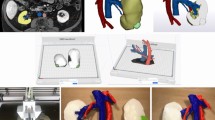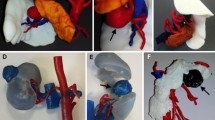Abstract
Objectives
Three-dimensional (3D) printing has been increasingly used to create accurate patient-specific 3D-printed models from medical imaging data. We aimed to evaluate the utility of 3D-printed models in the localization and understanding of pancreatic cancer for surgeons before pancreatic surgery.
Methods
Between March and September 2021, we prospectively enrolled 10 patients with suspected pancreatic cancer who were scheduled for surgery. We created an individualized 3D-printed model from preoperative CT images. Six surgeons (three staff and three residents) evaluated the CT images before and after the presentation of the 3D-printed model using a 7-item questionnaire (understanding of anatomy and pancreatic cancer [Q1–4], preoperative planning [Q5], and education for trainees or patients [Q6–7]) on a 5-point scale. Survey scores on Q1–5 before and after the presentation of the 3D-printed model were compared. Q6–7 assessed the 3D-printed model’s effects on education compared to CT. Subgroup analysis was performed between staff and residents.
Results
After the 3D-printed model presentation, survey scores improved in all five questions (before 3.90 vs. after 4.56, p < 0.001), with a mean improvement of 0.57‒0.93. Staff and resident scores improved after a 3D-printed model presentation (p < 0.05), except for Q4 in the resident group. The mean difference was higher among the staff than among the residents (staff: 0.50‒0.97 vs. residents: 0.27‒0.90). The scores of the 3D-printed model for education were high (trainees: 4.47 vs. patients: 4.60) compared to CT.
Conclusion
The 3D-printed model of pancreatic cancer improved surgeons’ understanding of individual patients’ pancreatic cancer and surgical planning.
Clinical relevance statement
The 3D-printed model of pancreatic cancer can be created using a preoperative CT image, which not only assists surgeons in surgical planning but also serves as a valuable educational resource for patients and students.
Key Points
• A personalized 3D-printed pancreatic cancer model provides more intuitive information than CT, allowing surgeons to better visualize the tumor’s location and relationship to neighboring organs.
• In particular, the survey score was higher among staff who performed the surgery than among residents.
• Individual patient pancreatic cancer models have the potential to be used for personalized patient education as well as resident education.




Similar content being viewed by others
Abbreviations
- 2D:
-
Two-dimensional
- 3D:
-
Three-dimensional
References
Stafford AT, Walsh RM (2015) Robotic surgery of the pancreas: the current state of the art. J Surg Oncol 112:289–294
Negoi I, Beuran M, Hostiuc S, Negoi RI, Inoue Y (2018) Surgical anatomy of the superior mesenteric vessels related to colon and pancreatic surgery: a systematic review and meta-analysis. Sci Rep 8:4184
Rhee H, Park MS (2021) The role of imaging in current treatment strategies for pancreatic adenocarcinoma. Korean J Radiol 22:23–40
Pietryga JA, Morgan DE (2015) Imaging preoperatively for pancreatic adenocarcinoma. J Gastrointest Oncol 6:343–357
Zheng YX, Yu DF, Zhao JG, Wu YL, Zheng B (2016) 3D printout models vs. 3D-rendered images: which Is better for preoperative planning? J Surg Educ 73:518–523
Brennan DD, Zamboni G, Sosna J et al (2007) Virtual Whipple: preoperative surgical planning with volume-rendered MDCT images to identify arterial variants relevant to the Whipple procedure. AJR Am J Roentgenol 188:W451-455
Bogdanova R, Boulanger P, Zheng B (2015) Three-dimensional eye tracking in a surgical scenario. Surg Innov 22:522–527
Ko BS, Kim N, Lee JW et al (2019) MRI-based 3D-printed surgical guides for breast cancer patients who received neoadjuvant chemotherapy. Sci Rep 9:11991
Kyung YS, Kim N, Jeong IG, Hong JH, Kim CS (2019) Application of 3-D printed kidney model in partial nephrectomy for predicting surgical outcomes: a feasibility Study. Clin Genitourin Cancer 17:e878–e884
Yoon SH, Park S, Kang CH, Park IK, Goo JM, Kim YT (2019) Personalized 3D-printed model for informed consent for stage I lung cancer: a randomized pilot trial. Semin Thorac Cardiovasc Surg 31:316–318
Kontovounisios C, Tekkis P, Bello F (2019) 3D imaging and printing in pelvic colorectal cancer: ‘The New Kid on the Block.’ Tech Coloproctol 23:171–173
Andolfi C, Plana A, Kania P, Banerjee PP, Small S (2017) Usefulness of three-dimensional modeling in surgical planning, resident training, and patient education. J Laparoendosc Adv Surg Tech A 27:512–515
Hong D, Lee S, Kim T et al (2020) Usefulness of a 3D-printed thyroid cancer phantom for clinician to patient communication. World J Surg 44:788–794
Michalski MH, Ross JS (2014) The shape of things to come: 3D printing in medicine. JAMA 312:2213–2214
Pugliese L, Marconi S, Negrello E et al (2018) The clinical use of 3D printing in surgery. Updates Surg 70:381–388
Alrasheed AS, Nguyen LHP, Mongeau L, Funnell WRJ, Tewfik MA (2017) Development and validation of a 3D-printed model of the ostiomeatal complex and frontal sinus for endoscopic sinus surgery training. Int Forum Allergy Rhinol 7:837–841
Langridge B, Momin S, Coumbe B, Woin E, Griffin M, Butler P (2018) Systematic review of the use of 3-dimensional printing in surgical teaching and assessment. J Surg Educ 75:209–221
Wake N, Rosenkrantz AB, Huang R et al (2019) Patient-specific 3D printed and augmented reality kidney and prostate cancer models: impact on patient education. 3D Print Med 5:4
Kulkarni NM, Hough DM, Tolat PP, Soloff EV, Kambadakone AR (2018) Pancreatic adenocarcinoma: cross-sectional imaging techniques. Abdom Radiol (NY) 43:253–263
Yoon SH, Lee JM, Cho JY et al (2011) Small (</= 20 mm) pancreatic adenocarcinomas: analysis of enhancement patterns and secondary signs with multiphasic multidetector CT. Radiology 259:442–452
Sahani DV, Shah ZK, Catalano OA, Boland GW, Brugge WR (2008) Radiology of pancreatic adenocarcinoma: current status of imaging. J Gastroenterol Hepatol 23:23–33
Elbanna KY, Jang HJ, Kim TK (2020) Imaging diagnosis and staging of pancreatic ductal adenocarcinoma: a comprehensive review. Insights Imaging 11:58
Boland GW, O’Malley ME, Saez M, Fernandez-del-Castillo C, Warshaw AL, Mueller PR (1999) Pancreatic-phase versus portal vein-phase helical CT of the pancreas: optimal temporal window for evaluation of pancreatic adenocarcinoma. AJR Am J Roentgenol 172:605–608
Al-Hawary MM, Francis IR, Chari ST et al (2014) Pancreatic ductal adenocarcinoma radiology reporting template: consensus statement of the Society of Abdominal Radiology and the American Pancreatic Association. Radiology 270:248–260
Zaky AM, Wolfgang CL, Weiss MJ, Javed AA, Fishman EK, Zaheer A (2017) Tumor-vessel relationships in pancreatic ductal adenocarcinoma at multidetector CT: different classification systems and their influence on treatment planning. Radiographics 37:93–112
Lu DS, Vedantham S, Krasny RM, Kadell B, Berger WL, Reber HA (1996) Two-phase helical CT for pancreatic tumors: pancreatic versus hepatic phase enhancement of tumor, pancreas, and vascular structures. Radiology 199:697–701
Ichikawa T, Erturk SM, Sou H et al (2006) MDCT of pancreatic adenocarcinoma: optimal imaging phases and multiplanar reformatted imaging. AJR Am J Roentgenol 187:1513–1520
Kim JH, Park SH, Yu ES et al (2010) Visually isoattenuating pancreatic adenocarcinoma at dynamic-enhanced CT: frequency, clinical and pathologic characteristics, and diagnosis at imaging examinations. Radiology 257:87–96
Vernuccio F, Messina C, Merz V, Cannella R, Midiri M (2021) Resectable and borderline resectable pancreatic ductal adenocarcinoma: role of the radiologist and oncologist in the era of precision medicine. Diagnostics (Basel) 11:2166
Gosnell J, Pietila T, Samuel BP, Kurup HK, Haw MP, Vettukattil JJ (2016) Integration of computed tomography and three-dimensional echocardiography for hybrid three-dimensional printing in congenital heart disease. J Digit Imaging 29:665–669
Kwon J, Choi J, Lee S et al (2020) Modelling and manufacturing of 3D-printed, patient-specific, and anthropomorphic gastric phantoms: a pilot study. Sci Rep 10:18976
Pereira da Silva N, Abreu I, Serodio M, Ferreira L, Alexandrino H, Donato P (2020) Advanced hepatic vasculobiliary imaging segmentation and 3D reconstruction as an aid in the surgical management of high biliary stenosis. BMC Med Imaging 20:120
Rivero Belenchon I, Congregado Ruiz CB, Gomez Ciriza G et al (2020) How to obtain a 3D printed model of renal cell carcinoma (RCC) with venous tumor thrombus extension (VTE) for surgical simulation (phase I NCT03738488). Updates Surg 72:1237–1246
Ganguli A, Pagan-Diaz GJ, Grant L et al (2018) 3D printing for preoperative planning and surgical training: a review. Biomed Microdevices 20:1–24
Cohen A, Laviv A, Berman P, Nashef R, Abu-Tair J (2009) Mandibular reconstruction using stereolithographic 3-dimensional printing modeling technology. Oral Surg Oral Med Oral Pathol Oral Radiol Endod 108:661–666
Schmauss D, Haeberle S, Hagl C, Sodian R (2015) Three-dimensional printing in cardiac surgery and interventional cardiology: a single-centre experience. Eur J Cardiothorac Surg 47:1044–1052
Tam MD, Laycock SD, Bell D, Chojnowski A (2012) 3-D printout of a DICOM file to aid surgical planning in a 6 year old patient with a large scapular osteochondroma complicating congenital diaphyseal aclasia. J Radiol Case Rep 6:31–37
Tam MD, Laycock SD, Brown JR, Jakeways M (2013) 3D printing of an aortic aneurysm to facilitate decision making and device selection for endovascular aneurysm repair in complex neck anatomy. J Endovasc Ther 20:863–867
Chun YS, Pawlik TM, Vauthey JN (2018) 8th Edition of the AJCC cancer staging manual: pancreas and hepatobiliary cancers. Ann Surg Oncol 25:845–847
Cong L, Liu Q, Zhang R et al (2018) Tumor size classification of the 8(th) edition of TNM staging system is superior to that of the 7(th) edition in predicting the survival outcome of pancreatic cancer patients after radical resection and adjuvant chemotherapy. Sci Rep 8:10383
Funding
This work was supported by the National Research Foundation of Korea (NRF) grant funded by the South Korean government (MSIT) (No. 2020R1F1A107153112 and No. 2022R1F1A107436211).
Author information
Authors and Affiliations
Corresponding author
Ethics declarations
Guarantor
The scientific guarantor of this publication is Ji Hye Min in the Department of Radiology and Center for Imaging Science, Samsung Medical Center, Sungkyunkwan University School of Medicine, Seoul, Republic of Korea.
Conflict of interest
The authors of this manuscript declare no relationships with any companies whose products or services may be related to the subject matter of the article.
Statistics and biometry
One (Seo-Youn Choi, MD, PhD) of the authors has significant statistical expertise.
Informed consent
The study protocol was explained and written informed consent was obtained from each participant.
Ethical approval
Institutional Review Board approval was obtained. (IRB number 2020–01-040).
Study subjects or cohorts overlap
No study subjects or cohorts overlap.
Methodology
• Prospective
• Observational study
• Performed at one institution
Additional information
Publisher's note
Springer Nature remains neutral with regard to jurisdictional claims in published maps and institutional affiliations.
Supplementary Information
Below is the link to the electronic supplementary material.
Rights and permissions
Springer Nature or its licensor (e.g. a society or other partner) holds exclusive rights to this article under a publishing agreement with the author(s) or other rightsholder(s); author self-archiving of the accepted manuscript version of this article is solely governed by the terms of such publishing agreement and applicable law.
About this article
Cite this article
Song, C., Min, J.H., Jeong, W.K. et al. Use of individualized 3D-printed models of pancreatic cancer to improve surgeons’ anatomic understanding and surgical planning. Eur Radiol 33, 7646–7655 (2023). https://doi.org/10.1007/s00330-023-09756-0
Received:
Revised:
Accepted:
Published:
Issue Date:
DOI: https://doi.org/10.1007/s00330-023-09756-0




